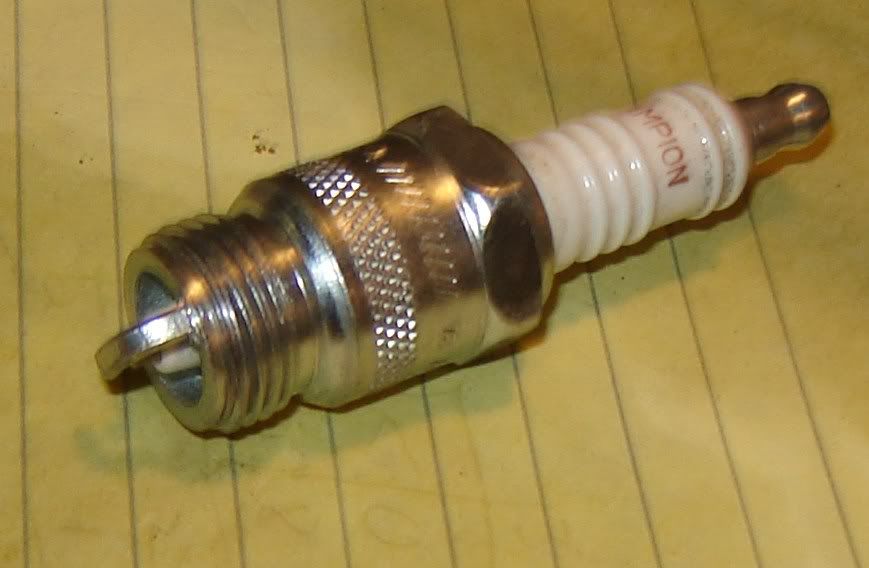 
 Main Menu
Main Menu
|
 Nevada Classics
Nevada Classics
|
 Advertise at CC
Advertise at CC
|
 November 2025
November 2025
|
| S |
M |
T |
W |
T |
F |
S |
| |
|
|
|
|
|
1 |
| 2 |
3 |
4 |
5 |
6 |
7 |
8 |
| 9 |
10 |
11 |
12 |
13 |
14 |
15 |
| 16 |
17 |
18 |
19 |
20 |
21 |
22 |
| 23 |
24 |
25 |
26 |
27 |
28 |
29 |
| 30 |
|
|
|
|
|
|
|
 CC Advertisers
CC Advertisers
|
|

09-21-2009, 10:20 AM
|
|
CC Member

|
|
|
Join Date: Jul 2009
Cobra Make, Engine:
Posts: 416
|
|

 Not Ranked
Not Ranked
 Valve Lash
Valve Lash
Well......I goofed. I set my valve lash on my solid lifter cam based on memory....memory of the wrong spec. It is suppposed to be 0.016 Intake and 0.018 Exhaust when hot. This should more or less equal 0.018 and 0.020 when cold. However, I set all valves to 0.025" cold.
Now I normally would think this can't effect performance very much, just valvetrain component longevity, however......
Reading up on all this, I find that a loose lash effectively makes the cam look smaller to the engine and that would tend to improve low-end torque at the expense of high end Hp.
BUT, a long time ago I bought a used MGB. An owner ran the engine dry of oil and the guy I bought it from re-did the engine by installing a Marina short-block. Odd thing was, I could squeal the tires from idle, but it would hardly go over 30 mph. Turned out the guy had adjsuted the valves for zero lash. I put it back to British-Leyland valve lash specs and everything was fiine. Engine would rev, and of course it would no longer squeal the tires at all.
Now that MGB story goes completely against what I've read about changing valve lash. Can anybody enlighten me a bit about it?

|
-
Advertising


09-21-2009, 11:14 AM
|
 |
CC Member

|
|
|
Join Date: Dec 2000
Location: Broken Arrow. OK ( South Tulsa), USA,
OK
Cobra Make, Engine: 66 COBRA FE 427 /4SP. (HCS Coupe w/ 408 Stroker and TKO 600 -sold)
Posts: 5,595
|
|

 Not Ranked
Not Ranked
I think you need to go the other way when cold! I seem to recall setting mine a little tighter when cold (.002-.006) and then once the engine was up to temp I would pull the vc back off and set the lash. But, a more knowledgable person might need to jump in and set us straight
Clois
__________________
Sunshine, Asphalt and no stop signs...Perfect
"Let's roll"
"Be part of Something Good
......Leave Something Good Behind!"
from CD "Long Road Out of Eden"
|

09-21-2009, 01:02 PM
|
|
CC Member

|
|
|
Join Date: Jul 2009
Cobra Make, Engine:
Posts: 416
|
|

 Not Ranked
Not Ranked
It depends. Cast iron block and heads don't expand much when heated, so lash shrinks with heat as pushrods (for one) grow. With aluminum heads, the head expands more than the pushrod grows, lifting the rocker assy higher and the lash increase. At least that's the way I understand it.
Here's a link:
http://69.20.53.62/faq_mlifter.php
I like setting lash cold as I can do it consistently (consistently wrong, it appears). With hot lash, the engine is a lot cooler by the time I get to the last few valves, so I"m sure lash adjustments are not consistent.
Best thing would be to set one set when hot, wait till everything is cold, then re-measure and set all others to that measurement. |

09-21-2009, 01:15 PM
|
|
Senior Club Cobra Member

|
|
|
Join Date: Jul 2002
Cobra Make, Engine:
Posts: 15,712
|
|

 Not Ranked
Not Ranked
Quote:
|
...the engine is a lot cooler by the time I get to the last few valves
|
THAT is exactly why I set my valve lash cold, I'm kinda slow at it... 
With the Formula Ford (1600 cc push rod, iron) SOME guys like to set their valves right on the edge of too tight. Theory being it opened/closed the valve just a little sooner, just a bit more power. A lot of the guys were on a budget and I would set their valves accurately, but not tight. I leaned toward long life over absolute performance, all around, but that did depend on the owner. Some would take more risk, push the envelope just a little further.
I think it came down to driving skill myself, the cars are all so closely matched anyway. |

09-21-2009, 03:52 PM
|
 |
CC Member

|
|
|
Join Date: Aug 2007
Location: NE Oklahoma,
OK
Cobra Make, Engine: Fords
Posts: 544
|
|

 Not Ranked
Not Ranked
Quote:
Originally Posted by Argess

"..............Now that MGB story goes completely against what I've read about changing valve lash. Can anybody enlighten me a bit about it?
|
with your MG you were getting more gas into the cylinders.
Z. Ray
__________________
'65 K code Mustang
'66 Galaxie 500
|

09-22-2009, 02:27 PM
|
 |
CC Member

|
|
|
Join Date: Feb 2008
Location: Cleveland,
UK
Cobra Make, Engine: #535 Kirkham 427, 427 Side Oiler
Posts: 157
|
|

 Not Ranked
Not Ranked
Gents,
I need to put you all right on this one. It's very important to get the valve lash correct. If it's too tight, the exhaust and (to some extent) the inlet valves will increase in length when exposed to high combustion temperatures and particularly if running WOT for a long period of time. If there is insufficient tappet clearance, the valve stem length will increase and take up all the lash and then the valves will never touch their seats. The motor will then lose compression, start back firing and also very quickly burn away the exhaust valve seats - game over. The correct valve lash for a ford FE with iron heads and block is:
0.025" hot.
This can be reduced by 0.008" for aluminium heads or 0.012" for aluminium block and heads.
Be warned, don't play around with valve lash thinking that it will affect performance - it won't, you'll just wreck your engine!
|

09-22-2009, 03:18 PM
|
|
CC Member

|
|
|
Join Date: Jul 2009
Cobra Make, Engine:
Posts: 416
|
|

 Not Ranked
Not Ranked
Yes, that 0.025 figure was the one I remembered from my Ford manual, but I didn't recall it as a hot setting, so I double goofed. Regardless, I will set my lash to the Crane spec called for with the cam I am using. I don't expect any performance difference, just increased longevity.
I will know in a few days. Will re-set the lash tomorrow (as they call for rain) and let the valve cover gaskets (with gasket shellac) dry over night. I'll find out as soon as I can go for a drive after that and report back.
Thank-you for all the replies though. I appreciate them.
|

09-22-2009, 04:18 PM
|
 |
CC Member

|
|
|
Join Date: Apr 2009
Location: Bethesda,
MD
Cobra Make, Engine: CSX 6022, navy blue, period correct 427 SO
Posts: 2,154
|
|

 Not Ranked
Not Ranked
Quote:
Originally Posted by Argess

Yes, that 0.025 figure was the one I remembered from my Ford manual, but I didn't recall it as a hot setting, so I double goofed.
|
I have been told that it is also OK to do the lash cold. Is that definitely incorrect? |

09-22-2009, 04:23 PM
|
|
CC Member

|
|
|
Join Date: Jul 2009
Cobra Make, Engine:
Posts: 416
|
|

 Not Ranked
Not Ranked
It's not the worst thing in the world if the egine is all cast iron,,...no aluminum heads or block. I think you may have heard "set it at the hot lash spec when cold, and then re-do it once warm" and that's meant for when you assemble an engine.
At any rate, I posted a link (above on it). Here it is again:
http://69.20.53.62/faq_mlifter.php |

09-23-2009, 09:20 AM
|
 |
CC Member

|
|
|
Join Date: May 2001
Location: California,
Ca
Cobra Make, Engine: NAF 289 Slabside Early Comp Car with 289 Webers and all the goodies. Cancelling the efforts of several Priuses
Posts: 6,592
|
|

 Not Ranked
Not Ranked
If specs call for Hot Lash, do it. Each cam grind is a little different, thus the lash specs are too. The ramps on the lobes are more aggresive on cams with a lot of lift and duration and a less aggresive on milder cams thus different lash specs. For those that dislike or find it difficult to work on a hot engine: If the lash calls for it to be set while hot, it can then be measured when "cold" and then set cold and that dimension (cold measurement) in the future.
I like to set one side as quickly as possible while hot, put the valve cover back on, restart the engine to get it back to full temp and then do the other side.
I just like the old school noise the solids evoke.
__________________
Rick
As you slide down the Banister of Life, may the splinters never be pointing the wrong way 
Last edited by Rick Parker; 09-23-2009 at 09:32 AM..
|

09-24-2009, 04:00 PM
|
|
CC Member

|
|
|
Join Date: Jul 2009
Cobra Make, Engine:
Posts: 416
|
|

 Not Ranked
Not Ranked

OK, set my lash yesterday, and put in new plugs while I was at it. Installed valve covers and let gasket shellac dry overnight.
Now, the performance test today. Well.....darn, I can't tell for sure if there was an improvement or not BECAUSE when I removed the plugs, I found a badly fouled one. More on this below (sidenote). However I am sure the plug did fire under light load, so I can say (without 100% confidence):
1/ With the tighter lash (Crane correct lash), the idle dropped. I had to turn both carb idle stop screws in a little over 1/4 turn. Best guess for this was tightening lash increased valve overlap.
2/ Low rpm power seemed snappier, but this could also have been from changing plugs. But I do believe it helped as the cam should appear more "advanced" with a tighter lash.
3/ It seems a little bit quieter (as one would expect) but hard to tell over the exhaust, even while cruising.
4/ high rpm was always great and I admit to never taking advantage of all the power available, so no difference there that I can see, but that's due to my driving style.
Sidenote:
Seeing that 1 bad plug was worriesome. I knew the engine doesn't smoke, so that was in my favour. I did a compression test and a leak-down test, and compared it to another cylinder. Identical readings. Compression test was wacky (as in very high)....after I rebuilt this engine in the spring, I got 195 psi. Now I am getting 220 psi. Must be due to rings wearing in, although I can't remember for sure if I held the throttle open during the first compression test last spring. I also checked valve rise and fall and found everyting OK in that regard.
I had an internal carb leak on the rear carb, which I recently fixed. Before I fixed it,. back four cylinders were running richer than the front four as indicated by reading the plugs. So it's possible this plug fouled due to the carb leak, and couldn't clean itself after I fixed the carb, while the others did.
But, even though I say I checked them, the truth is I never did check #4 cylinder as the plug is a bit tricky to remove/install due to the close proximity of the battery. Actually, it's getting the plug wire back on securely that's the difficulty....dont' laugh until you try it! So, the plug could have been damaged by the crossfire I was having during the humid part of summer, although I can't see a crack in the porcelin. I did test the plug on my ancient AC Delco SparkPlug checker/cleaner and it failed miserably.
This plug was one of a set of RF11YCs I installed as no RF9YCs were in stock. I did acquire 8 RF9YCs the other day, but NAPA said there was none at the warehouse so manged to get me NOS from two of there other stores.
By the way, I think Champion quality is going down hill. Check these pics:

One of those two is not like the other......top one is constructed properly

Hard to see, but threads are deformed at bottom. Note how threads converge near side electrode. Came that way. I didn't notice until I tried to install it. I guarentee I didn't cross-thread it myself, as I always use my fingers to start plugs. Of course, maybe I had Wheaties for breakfast that day.....LOL.

|
 Posting Rules
Posting Rules
|
You may not post new threads
You may not post replies
You may not post attachments
You may not edit your posts
HTML code is Off
|
|
|
All times are GMT -7. The time now is 06:23 AM.
|























 Linear Mode
Linear Mode



